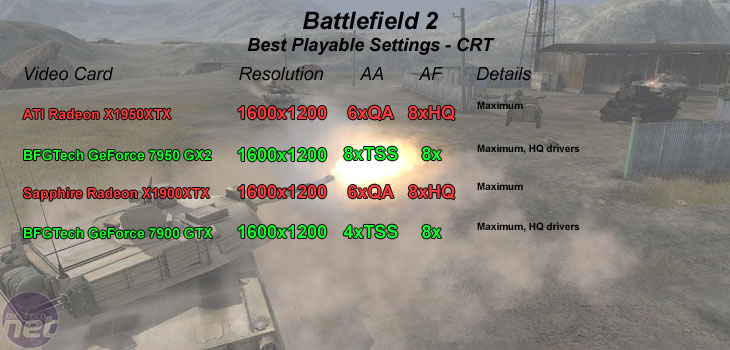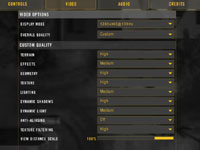For gameplay evaluations on a 24" widescreen monitor, please head straight to our widescreen performance section.
Battlefield 2 features an all-new game engine based on the DirectX 9.0 API. There is no Shader Model 3.0 support, but the majority of hardware will use a Shader Model 2.0++ mode that includes support for Normal Maps, Parallax Mapping, Full-Resolution Dynamic Shadowing, Post Processing and Fog.
The game will look the same on both NVIDIA and ATI hardware, so there is no advantage of choosing one over the other in image quality related circumstances. The only major difference is that Ultra Shadow 2 is utilised on NVIDIA's hardware, while the shadowing on ATI hardware is done using a slightly different technique.
We patched the game to version 1.3 and then played three five-minute segments of the 'Strike at Karkand' map, reporting the median frame rate. We found that there was no ready way to duplicate testing situations manually in this game, so we felt that taking a typical slice of action from the game was the best way to report our findings. We controlled anti-aliasing from inside the game, while anisotropic filtering was set to 8xAF when the 'Texture Filtering' option was set to 'High'.

 We are back to the same situation that we had in Half-Life 2: Episode One, where the Radeon X1950XTX delivered smooth gameplay at 1600x1200 6x quality adaptive AA, while the GeForce 7950 GX2 treated us with an equally smooth experience with 8x transparency supersampling AA enabled. Battlefield 2 is another game where NVIDIA's texture optimisations result in some pretty shoddy texture filtering, so we forced the high quality driver setting.
We are back to the same situation that we had in Half-Life 2: Episode One, where the Radeon X1950XTX delivered smooth gameplay at 1600x1200 6x quality adaptive AA, while the GeForce 7950 GX2 treated us with an equally smooth experience with 8x transparency supersampling AA enabled. Battlefield 2 is another game where NVIDIA's texture optimisations result in some pretty shoddy texture filtering, so we forced the high quality driver setting.
The differences in image quality were small when it came to edge aliasing, with a slight advantage to the GeForce 7950 GX2. Once you get above 4xAA at high resolution, aliasing in games tends to be fairly minimal if you've got some transparent texture AA enabled too - therefore the differences between 8xAA and 6xAA are incredibly small. However, texture filtering was the area where ATI excelled again - the high quality anisotropic filtering really does help to remove texture shimmering that can be quite apparent in BF2.
If you consider 6xAA to be enough AA, the advantages on the texture filtering front were quite large in some instances, thus we would say that the Radeon X1950XTX delivered a better gameplay experience.
Battlefield 2
Publisher: Electronic ArtsBattlefield 2 features an all-new game engine based on the DirectX 9.0 API. There is no Shader Model 3.0 support, but the majority of hardware will use a Shader Model 2.0++ mode that includes support for Normal Maps, Parallax Mapping, Full-Resolution Dynamic Shadowing, Post Processing and Fog.
The game will look the same on both NVIDIA and ATI hardware, so there is no advantage of choosing one over the other in image quality related circumstances. The only major difference is that Ultra Shadow 2 is utilised on NVIDIA's hardware, while the shadowing on ATI hardware is done using a slightly different technique.
We patched the game to version 1.3 and then played three five-minute segments of the 'Strike at Karkand' map, reporting the median frame rate. We found that there was no ready way to duplicate testing situations manually in this game, so we felt that taking a typical slice of action from the game was the best way to report our findings. We controlled anti-aliasing from inside the game, while anisotropic filtering was set to 8xAF when the 'Texture Filtering' option was set to 'High'.


The differences in image quality were small when it came to edge aliasing, with a slight advantage to the GeForce 7950 GX2. Once you get above 4xAA at high resolution, aliasing in games tends to be fairly minimal if you've got some transparent texture AA enabled too - therefore the differences between 8xAA and 6xAA are incredibly small. However, texture filtering was the area where ATI excelled again - the high quality anisotropic filtering really does help to remove texture shimmering that can be quite apparent in BF2.
If you consider 6xAA to be enough AA, the advantages on the texture filtering front were quite large in some instances, thus we would say that the Radeon X1950XTX delivered a better gameplay experience.

MSI MPG Velox 100R Chassis Review
October 14 2021 | 15:04










Want to comment? Please log in.